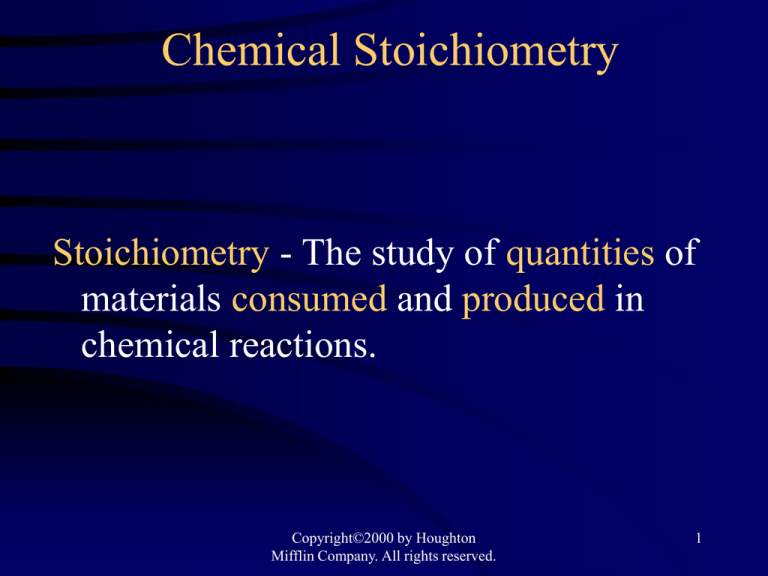
Chemical Stoichiometry
Stoichiometry - The study of quantities of
materials consumed and produced in
chemical reactions.
Copyright©2000 by Houghton
Mifflin Company. All rights reserved.
1
Atomic Masses
Elements occur in nature as mixtures of
isotopes
Carbon =
98.89% 12C
1.11% 13C
<0.01% 14C
Carbon atomic mass = 12.01 amu
Copyright©2000 by Houghton
Mifflin Company. All rights reserved.
2
Atomic Mass
Atoms are so small, it is difficult to discuss
how much they weigh in grams
Use atomic mass units.
an atomic mass unit (amu) is one twelfth the
mass of a carbon-12 atom
This gives us a basis for comparison
The decimal numbers on the table are atomic
masses in amu
They are not whole numbers
Because they are based on averages of atoms
and of isotopes.
can figure out the average atomic mass from
the mass of the isotopes and their relative
abundance.
add up the percent as decimals times the
masses of the isotopes.
The Mole
•
•
•
•
The mole is a number
a very large number, but still, just a number
6.022 x 1023 of anything is a mole
a large dozen
The Mole
The number equal to the number of carbon
atoms in exactly 12 grams of pure 12C.
1 mole of anything = 6.022 1023 units of
that thing
Copyright©2000 by Houghton
Mifflin Company. All rights reserved.
6
Avogadro’s number
equals
23
6.022 10 units
Copyright©2000 by Houghton
Mifflin Company. All rights reserved.
7
Molar Mass
A substance’s molar mass (molecular
weight) is the mass in grams of one mole of
the compound.
CO2 = 44.01 grams per mole
Copyright©2000 by Houghton
Mifflin Company. All rights reserved.
8
Percent Composition
Mass percent of an element:
mass of element in compound
mass %
100%
mass of compound
For iron in iron (III) oxide, (Fe2O3)
111.69
mass % Fe
100% 69.94%
159.69
Copyright©2000 by Houghton
Mifflin Company. All rights reserved.
9
Formulas
molecular formula = (empirical formula)n
[n = integer]
molecular formula = C6H6 = (CH)6
empirical formula = CH
Copyright©2000 by Houghton
Mifflin Company. All rights reserved.
10
Empirical Formula Determination
1. Base calculation on 100 grams of
compound.
2. Determine moles of each element in 100
grams of compound.
3. Divide each value of moles by the smallest
of the values.
4. Multiply each number by an integer to
obtain all whole numbers.
Copyright©2000 by Houghton
Mifflin Company. All rights reserved.
11
Working backwards
From percent composition, you can determine
the empirical formula.
Empirical Formula the lowest ratio of atoms
in a molecule
Based on mole ratios
A sample is 63.68% C, 9.80 %H, 12.38%N,
and 14.14%O what is its empirical formula.
(question #70; p.119_
Example: Question 79, p.119
Cumene is a compound containing only
carbon and hydrogen that is used in the
production of acetone and phenol.
Combustion of 47.6 mg cumene produces
some CO2 and 42.8 mg water. The molar
mass of cumene is between 115 and 125
g/mol. What is the empirical formula and
the molecular formula of cumene?
Pure O2 in
Sample is burned
completely to
form CO2 and
H2O
CO2 is absorbed
H2O is absorbed
Empirical To Molecular
Formulas
•
•
•
•
Empirical is lowest ratio
Molecular is actual molecule
Need Molar mass
Ratio of empirical to molar mass will tell
you the molecular formula
• Must be a whole number because...
Chemical Equations
Chemical change involves a
reorganization of the atoms in one or
more substances.
Copyright©2000 by Houghton
Mifflin Company. All rights reserved.
16
Chemical Equations
• Are sentences.
• Describe what happens in a chemical
reaction.
• Reactants Products
• Equations should be balanced
• Have the same number of each kind of
atoms on both sides because ...
Chemical Equation
A representation of a chemical reaction:
C2H5OH + 3O2 2CO2 + 3H2O
reactants
products
Copyright©2000 by Houghton
Mifflin Company. All rights reserved.
18
Abbreviations
• (s) , for product)
• (g) , for product)
• (aq)
•
heat
•
D
• catalyst
Meaning
• A balanced equation can be used to
describe a reaction in molecules and atoms.
• Not grams.
• Chemical reactions happen molecules at a
time
• or dozens of molecules at a time
• or moles of molecules.
Chemical Equation
C2H5OH + 3O2 2CO2 + 3H2O
The equation is balanced.
1 mole of ethanol reacts with 3 moles of
oxygen
to produce
2 moles of carbon dioxide and 3 moles of
water
Copyright©2000 by Houghton
Mifflin Company. All rights reserved.
21
Calculating Masses of Reactants
and Products
1.
2.
3.
4.
Balance the equation.
Convert mass to moles.
Set up mole ratios.
Use mole ratios to calculate moles of
desired substituent.
5. Convert moles to grams, if necessary.
Copyright©2000 by Houghton
Mifflin Company. All rights reserved.
22
Limiting Reactant
The limiting reactant is the reactant
that is consumed first, limiting the
amounts of products formed.
Copyright©2000 by Houghton
Mifflin Company. All rights reserved.
23
Limiting Reagent
• Reactant that determines the amount of
product formed.
• The one you run out of first.
• Makes the least product.
• Book shows you a ratio method.
• It works.
• So does mine
Limiting reagent
• To determine the limiting reagent requires
that you do two stoichiometry problems.
• Figure out how much product each reactant
makes.
• The one that makes the least is the limiting
reagent.
Solving a Limiting Reactant
Problem
1.
2.
3.
4.
Balance the equation.
Convert masses to moles.
Determine which reactant is limiting.
Use moles of limiting reactant and mole
ratios to find moles of desired product.
5. Convert from moles to grams.
Copyright©2000 by Houghton
Mifflin Company. All rights reserved.
26
Percent Yield
% yield = Actual
Theoretical
x 100%
% yield = what you got
x 100%
what you could have got
Copyright©2000 by Houghton
Mifflin Company. All rights reserved.
27









